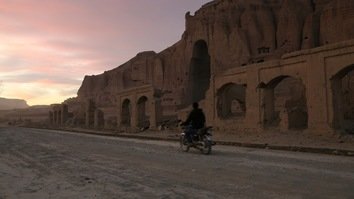KABUL -- Dozens of Afghan archaeologists were among the crowds of Afghans evacuated from Kabul following the takeover of the country by the Taliban.
As fears mounted over a return to the dark rule of the Taliban, there was also concern the group will work to undermine all the efforts that have been undertaken over the past 20 years to preserve Afghanistan's cultural heritage.
The international community, particularly NATO member countries, has invested significantly in the restoration and preservation of Afghanistan's historical and cultural heritage since the Taliban were overthrown in 2001.
Millions of dollars were spent refurbishing the National Museum of Afghanistan up to international professional standards, and international organisations helped recover thousands of illegally smuggled items, the New York Times reported in August.
![Afghan boy Asghar, 18, practices his bicycle riding skills near the ruined Darul Aman Palace in Kabul on May 26, 2015. Renovation of the palace took place between 2016 and 2020. The project underscored the value that Afghanistan places on preserving its archaeological and architectural heritage. [Farshad Usyan/AFP]](/cnmi_st/images/2021/09/20/31415-palace_1-585_329.jpg)
Afghan boy Asghar, 18, practices his bicycle riding skills near the ruined Darul Aman Palace in Kabul on May 26, 2015. Renovation of the palace took place between 2016 and 2020. The project underscored the value that Afghanistan places on preserving its archaeological and architectural heritage. [Farshad Usyan/AFP]
The museum now contains artefacts dating to the Stone Age, as well as to the Bronze, Buddhist, Hindu and Islamic periods.
Protecting Afghanistan's heritage
Donors such as France, Japan, the Czech Republic, Austria and other countries have made significant contributions in the past two decades to rebuild Afghanistan's historical heritage, said Salim Paigir, a political analyst in Kabul.
The evacuation of archaeologists and others who specialise in the restoration and preservation of historical sites is a means of "protecting those who devoted their profession for preserving the country's historical and cultural heritage", he said.
"We are very grateful for their efforts," he added.
The targeting of archaeologists and other specialists could set back Afghanistan's cultural history and waste the efforts of the countries that have worked in this field, said Paigir.
"I thank these countries for safeguarding the lives of [these] Afghans, who may otherwise be targeted by extremist groups," said Mohammad Edress, 27, a university student in Kabul.
Such Afghans have made great achievements by restoring historical and cultural monuments, he said.
Farzad, 26, a Kabul resident and media activist who gave only his first name for security reasons, also agreed that "with the help of donors, Afghan archaeologists and professionals played a vital role in restoring and preserving our historical identity".
By evacuating them, the United States and its allies are protecting the investments made by the international community in the restoration and preservation of Afghanistan's historical sites, he said.
Taliban promises
The evacuations come amid concerns that the Taliban might target Afghanistan's cultural heritage and destroy valuable artefacts they consider idolatrous.
This would not be the first time the group committed atrocities against cultural symbols in the country. In March 2001, the Taliban blasted Afghanistan's famed Buddhas of Bamiyan out of the alcoves in the rugged central highlands where they had stood for centuries.
The Taliban demolished the statues on the orders of then-leader Mullah Mohammad Omar after they declared them to be idols.
Carved into a cliff in the Bamiyan valley in the 4th and 5th centuries, the two were once the tallest standing Buddhas in the world at 35 and 53 metres tall.
Now, the Taliban say they have ordered fighters to "robustly protect, monitor and preserve" relics, halt illegal digs, and safeguard "all historic sites", the National Geographic reported August 13, citing a Taliban statement in February in which they promised to forbid selling artefacts on the art market.
Taliban officials have also vowed to protect the National Museum of Afghanistan in Kabul, according to the New York Times.
Afghans are sceptical, however.
"Now that the Taliban have regained power, they are talking about a change in themselves, but unfortunately, we do not see that much change in their behaviour," Abdul Khaliq Kharoti, a lecturer at Kabul University, told Salaam Times.
"We have recently witnessed how the Taliban destroyed a sculpture of Abdul Ali Mazari in Bamiyan province," he said.
The statue of the prominent anti-Taliban fighter killed by the group before they took power for the first time in the 1990s was decapitated in Bamiyan city, residents said August 18.
Mazari, a political leader who represented Afghanistan's ethnic Hazara community, was declared a national martyr in 2016 -- more than two decades after the Taliban said he had died in a gunfight aboard a helicopter.

![In this picture taken on March 5, a general view shows the site of the giant Buddha statues, which were destroyed by the Taliban in 2001, in Bamiyan province. [Wakil Kohsar/AFP]](/cnmi_st/images/2021/09/20/31407-000_94e3gp__1_-585_329.jpg)
![In this photograph taken on March 14, 2017, Italian restoration specialist Ermano Carbonara gestures towards a statue of Buddha at the French Archaeological Delegation to Afghanistan (DAFA) office in Kabul. [Wakil Kohsar/AFP]](/cnmi_st/images/2021/09/20/31409-000_mp6fa-585_329.jpg)
![A Buddha statue that was found in Sarai Khowja, 33km north of Kabul, in 1965 and dating back to the 2nd-4rd century CE is exhibited in the Kabul Museum October 13, 2012. [Jawad Jalali/AFP]](/cnmi_st/images/2021/09/20/31410-000_del6158917-585_329.jpg)
![Afghan visitors look at displays of Afghan heritage at the Kabul Museum in Kabul on October 13, 2012. [Jawad Jalali/AFP]](/cnmi_st/images/2021/09/20/31411-000_del6158920-585_329.jpg)






